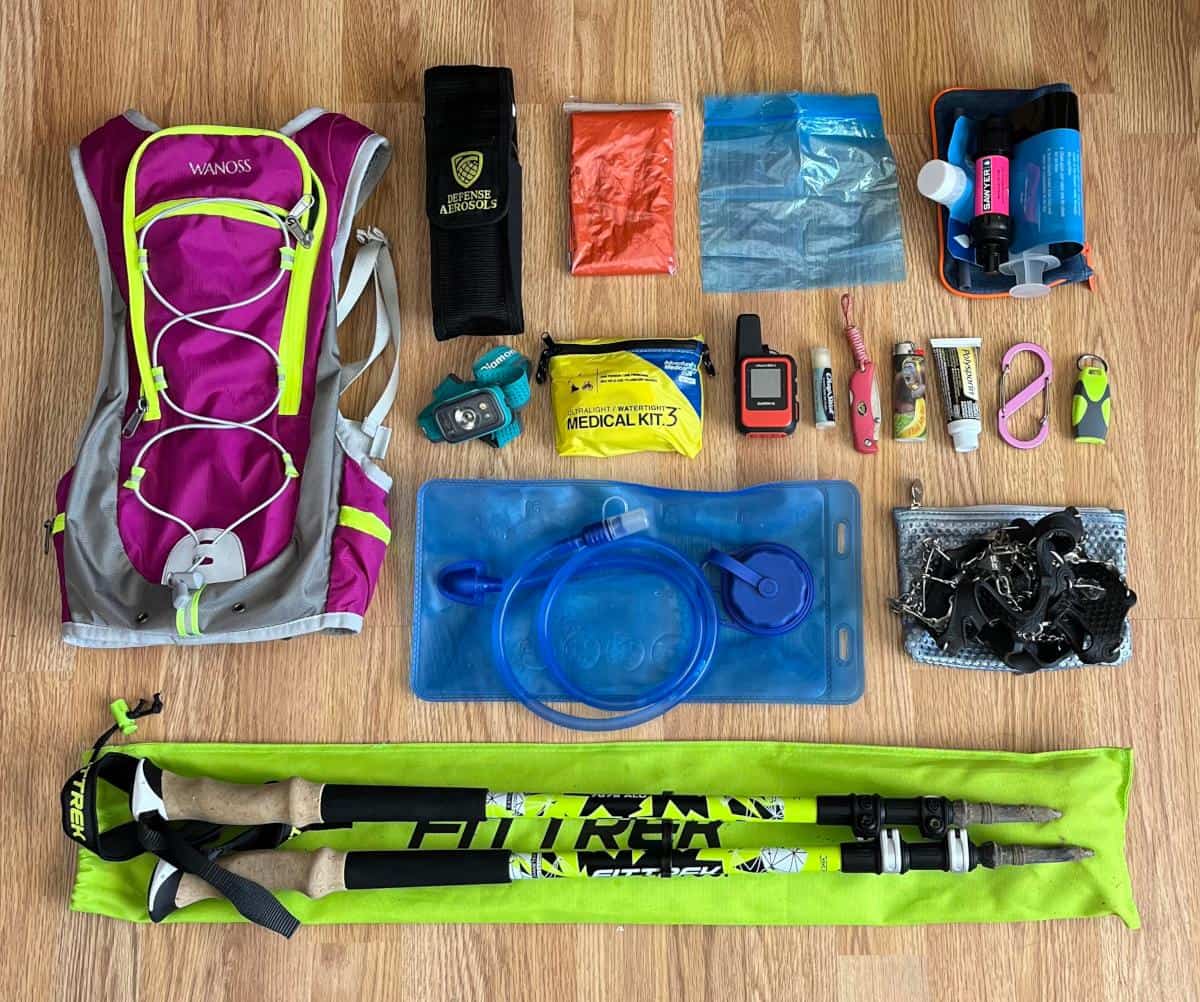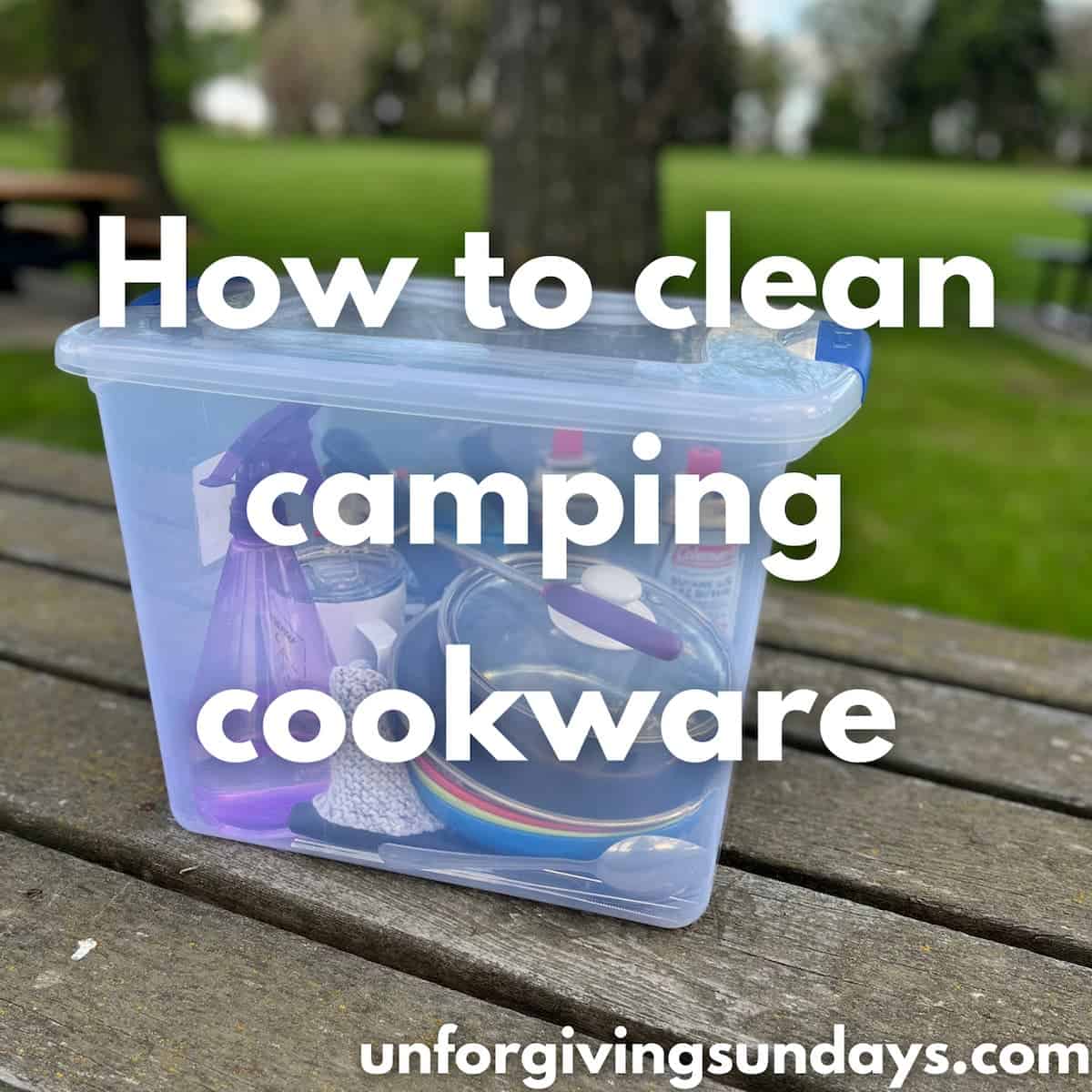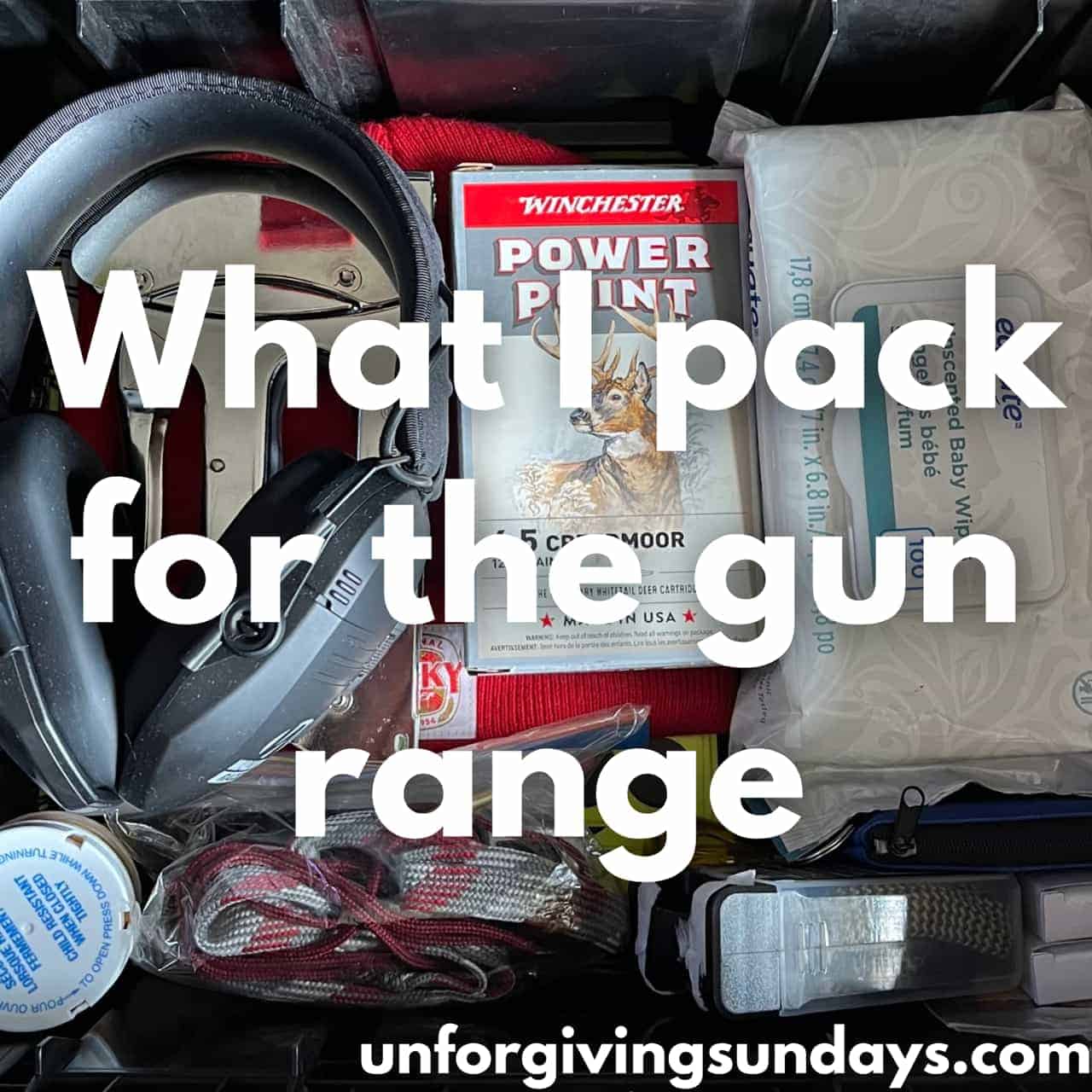Maybe you are getting ready for your first hike. Maybe you go on frequent adventures and are wondering what you could add (or take away!) from your current set-up. Or maybe you just like gear. Well, let me show you what I keep in my hiking backpack for a day on the trail!

If you live an hour from the Rocky Mountains and aren’t spending your weekends hiking, fishing, snowshoeing, or camping, then you aren’t doing it right. As such, I have had lots of time to fine-tune the contents of my hiking daypack. First, we will talk about the 10 Essentials, and then we will go pocket-by-pocket and talk about what is (or isn’t!) in my backpack, and why.
The 10 Essentials
When you go out into the wild, you should be prepared to take care of yourself if something was to happen. The experts from Mountaineering: The Freedom of the Hills suggest that, at a minimum, you always carry these “10 Essentials”:
- Navigation
- Headlamp
- Sun protection
- First aid
- Knife
- Fire
- Shelter
- Extra food
- Extra water
- Extra clothes
It is a good list, and I do [mostly] carry these things — after all, who am I to disagree with the experts?
Hiking Backpack — Main Pockets


In the smaller front pocket, I keep:
- Headlamp
- Emergency blanket
In the larger back pocket, I keep:
- Water bladder
- Shoe spikes
- Sawyer Mini water filter
- Food (not pictured)
Headlamp: A headlamp is something I used to carry “because I have to” — when am I going to need a headlamp on a day hike? You never think you’ll need it until you do. Last summer, I was out by myself and decided to take a different route down, which ended up adding two hours to my hike… and then my phone died. I got to my car 15 minutes before it got dark. Although I didn’t end up using it, I was really thankful to know it was there.
Emergency blanket: Have I ever used the emergency blanket? No… but it is cheap and light, and could really make a difference if something ever happened. In terms of the 10 Essentials, this is the item I keep in my hiking backpack to satisfy the “shelter” requirement.
Water bladder: I use a water bladder instead of a water bottle because it fits better in a small pack like mine. I like that it has a wide mouth so I can fit ice cubes; the downside is that the heat of my body against the backpack warms the water up quickly.
Shoe spikes: As a Canadian, I like to carry shoe spikes. These slip over my boots (hiking or snow) and really help with traction. They are good for snow and ice, but they also work really well in muddy grass. I store them in a pouch, which keeps them together and keeps the grime out of my backpack. I like to have these on me because you never know when they might come in handy, but I leave them in the car for July and August.
Water filter: You should always have a backup plan, even on short hikes, in case you run out of water. There are lots of different options for purifying water, but I have a Sawyer Mini water filtration system. It comes with a drinking pouch that you could fill up in a stream, and then the filter screws on and you are able to drink like a straw from the filter. I keep everything in another pouch.
Food: I usually pack a sandwich and snacks. My favorite snacks to bring are fruit, pepperoni, and trail mix. Whatever you decide to bring, make sure to pack extra, just in case.
Hiking Backpack — Waist Pockets

In the left waist pocket, I keep:
- Ziploc bag
- First aid kit – with an extra day of prescription medications and tweezers for ticks
- Chapstick
- Lighter
- Pocket knife
- Polysporin
In the right waist pocket, I keep:
- Cell phone
- Car keys
Ziploc bag: These come in handy at the weirdest times, but the main reason I carry a Ziploc bag is to pack out any of my own garbage or garbage that I find along the way.
First aid kit: I always scoffed at first aid kits but begrudgingly carried one anyway — until one day when I was hiking back to the car and I started to get a blister. I continued on because we weren’t more than a half hour from the car. Minutes later, the blister had become so bad that I couldn’t walk any more. If it wasn’t for my first aid kit, I probably would’ve had to take my shoes off to finish the hike. After that experience, I will happily carry a first aid kit (with extra Leukotape!) in my hiking backpack for the rest of my life. In my first aid kit, I also keep a pair of tweezers (in case of ticks) and an extra day of prescription medication (and replace it each season).
Chapstick: Not everyone will want to carry Chapstick, but if this is something that you like to use, you’ll be thankful to have it in your backpack. Plus, it really doesn’t take up much space.
Lighter: If something happened and you had to spend a night in the woods, having a fire could be the difference between having a bad time and having a horrible time. If you feel like being extra prepared, you might want to consider carrying two ways to start a fire (e.g., matches and a ferro rod).
Pocket knife: My little pink pocket knife isn’t going to be able to cut everything, but it would do the trick if I needed to cut fabric, rope, gauze, or Leukotape.
Polysporin: I recently replaced the expired items in my first aid kit. I couldn’t find any antibiotic ointment packets, so I carry a little tube of Polysporin.
Right waist pocket: I keep this pocket empty, and then always put my phone and keys in this pocket so I know exactly where they are. I like to use AllTrails to track my hikes on my phone.
Hiking Backpack — Outside of the Bag


On the back of the bag, I keep:
- Trekking poles
- Carabiner
On the straps of the bag, I keep:
- Whistle
- Garmin inReach Mini satellite communicator
- Bear spray
Trekking poles + carabiner: I find that the times where I don’t bring trekking poles end up being the times where I want trekking poles. I’ve started attaching them to my hiking daypack, so that they are always there if I want them. I use the carabiner to secure the poles to the backpack.
Whistle: I carry a whistle to signal for help, if needed. I keep it on the outside of my bag, close to my face, so that I could still use it with limited mobility.
Satellite communicator: I have a Garmin inReach Mini satellite communicator, especially because I like to hike by myself. This is a nice way to check in when I don’t have service, and it includes my location with the message. Plus, I can send SOS messages to Garmin, in the event of an emergency.
Bear spray: I always carry bear spray on my waist. Even in the winter, you never know when a dangerous animal might approach you.
Other Things That I Might Pack in My Hiking Daypack
If you compare my list with the 10 Essentials, you’ll notice there are a few things I don’t carry regularly. It is not that I don’t think you should carry these things–again, who am I to question the experts–but it really depends on the situation.
Navigation: At first, I wasn’t the best at this. I have started to get better. I obsessively track my hikes using AllTrails (because I love having the metrics) and it is nice because you can use it follow your tracks if you get lost. But phones die. I’ve started also carrying a printed map or a guidebook. If you don’t mind the weight, I like the guidebooks because sometimes they contain additional information that AllTrails is missing (e.g., turn left at the big rock) — this has come in handy when the trail isn’t clear.
Sun protection: I always wear sunscreen but I don’t pack it on short day hikes (i.e., less than five hours). I always have sunscreen in the car, along with insect repellent, and apply it at the trail head before I start my hike (I know, I know — I should be reapplying more). Also, I always wear a hat.
Extra clothes: I tend to dress in layers so that I can add and remove things as needed, so I don’t usually bring “extra” clothes. However, I might change my mind if it was really wet out. You might want a windbreaker as you get higher up the mountain; it can also be worthwhile to bring an extra pair of socks. Regardless, it is important to know about hypothermia and hyperthermia so that you can be prepared.
Summary
So there you have it! This is what is in my hiking backpack!

If I was just starting out, I would pack the 10 Essentials. From there, I would adjust the contents as I learn what works for me. There is no one-size-fits-all, but it is important that you are able to look after yourself in the event of an emergency.
Do you think there is anything I missed? Let me know in the comments.




Leave a Reply